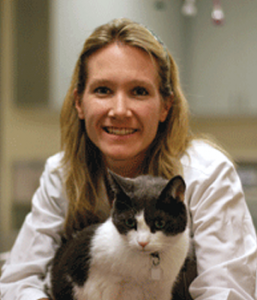-
Adopt
-
Veterinary Care
Services
Client Information
- What to Expect – Angell Boston
- Client Rights and Responsibilities
- Payments / Financial Assistance
- Pharmacy
- Client Policies
- Our Doctors
- Grief Support / Counseling
- Directions and Parking
- Helpful “How-to” Pet Care
Online Payments
Referrals
- Referral Forms/Contact
- Direct Connect
- Referring Veterinarian Portal
- Clinical Articles
- Partners in Care Newsletter
CE, Internships & Alumni Info
CE Seminar Schedule
Emergency: Boston
Emergency: Waltham
Poison Control Hotline
-
Programs & Resources
- Careers
-
Donate Now
 By Lisa Maciorakowski, DVM
By Lisa Maciorakowski, DVM
angell.org/generalmedicine
617-522-7282
Going to the doctor’s office can be a nerve-wracking experience for almost anyone, but imagine going through that visit without being able to understand the purpose, and without the reassurance that everything being done is in your best interest. In a way similar to that of babies and very young children visiting the pediatrician, our kitties are often faced with a visit to the veterinarian that is absolutely terrifying. The level of your kitty’s fear is a valid concern that veterinarians are increasingly taking into consideration in the design of their hospital and in their routine handling of their cat patients. When looking to establish care at a veterinary clinic, it is fair to inquire about a clinic’s “cat friendliness” so that your kitty can have as fear free of an experience as possible.
By definition, a “Cat-Friendly Practice” is one that provides excellent service to cat owners through a great quality of medicine to their feline family members all in a calm environment with minimal stress. It involves a team whose members respect cats and understand why cats react as they do when they are fearful. The animal hospitals that are certified by the American Association of Feline Practitioners as a Cat-Friendly hospital are listed in the Association’s online databases. They are listed as “Silver” or “Gold” status depending on whether they meet the essential or optimum level of Cat-Friendly criteria.
Although the cat is the most popular pet in the US, millions of pet cats receive little to no needed vet care and suffer unrecognized pain/illness. One of the major reasons for this lack of cat vet care is the concern that owners have that the experience will be too stressful for their cat. By decreasing patient fear (and associated owner stress), the veterinary experience can be made more efficient, seen as a greater value, made safer for everyone, and the quality of care the cat receives can be improved. This can lead to the likelihood of increased cat visit returns and thus better owner education in understanding the importance of preventative care and learning about the subtle signs of illness that cats show.
The key in designing and implementing a fear-free program center around understanding the cat…..being able to view the environment from their perspective, accurately interpreting their subtle body language signs, and thereby adjusting our interactions with them in a considerate way that involves gentle control. We need to remember that they are prey animals that hide signs of illness and when they perceive a situation as threatening they will take flight, fight, freeze, or fidget. Being empathetic to their nature and behaviors can help in reducing their Fear, Anxiety and Stress (FAS).
 The important first steps in decreasing the level of FAS should actually start at home. The cat should have several days prior to the visit where he is desensitized to his cat carrier. It should be left out in a warm, sunny area surrounded by happy things so that the first time he sees it is not when he’s pushed inside, jostled into a car and taken to the vet hospital. Each cat should have their own carrier and it should be secure and have a top and side opening for easy access. It can be covered with a towel to help the cat feel safe. The carrier should be carried with both hands from the bottom to minimize motion. Sometimes using a synthetic calming pheromone spray (like Feliway) in the car or carrier a half hour prior to departure can help soothe them as well.
The important first steps in decreasing the level of FAS should actually start at home. The cat should have several days prior to the visit where he is desensitized to his cat carrier. It should be left out in a warm, sunny area surrounded by happy things so that the first time he sees it is not when he’s pushed inside, jostled into a car and taken to the vet hospital. Each cat should have their own carrier and it should be secure and have a top and side opening for easy access. It can be covered with a towel to help the cat feel safe. The carrier should be carried with both hands from the bottom to minimize motion. Sometimes using a synthetic calming pheromone spray (like Feliway) in the car or carrier a half hour prior to departure can help soothe them as well.
Upon arrival, a cat-friendly clinic should have a cat-only waiting area that is separated from the dogs. Some will have ways that you can keep the carrier up (like on a cart for easier transport) or lead you straight to an exam room, if possible, to avoid anything that could frighten the cat in the waiting room. Some other attributes of a cat-friendly clinic are providing cat-only blocks of appointments in an exam room designed exclusively for cats. This way there will be fewer odors of dogs on the doctor or in the immediate environment. The rooms should be cleaned with only neutral smelling cleaning products so that cats with a sensitive sense of smell will not be upset. There should be no places for the cat to get stuck; no-slip, soft surfaces; easy access hiding spots; and access to treats that can help induce a feel-good emotion.
The cat’s medical and emotional history should be taken in a quiet, calm way as the cat gets acclimated to the environment. There should be good client communication regarding the cat’s emotional state and what is going to be done about it. The doctors who work as part of a cat-friendly hospital understand the importance of being flexible during their exams and handling of the cats so that the cats can maintain a sense of control. This often means performing the exam wherever the cat is most comfortable- on a lap, in the bottom half of their carrier, on the scale, in a bed. The exam room lights should be kept lower and the environment should be consistently quiet and calm. Limited exits and entries into the room can be achieved by stocking each room in preparation for each individual patient.
The vet staff who are trained to work with cats know to speak softly, move slowly, approach from the side, and massage the cat’s forehead/face/neck to mimic allogrooming (how friendly cats interact). It is often best to keep the cat facing their family during the exam. Minimal restraint with few restrainers is best. A touch gradient is employed so that the cat is not repeatedly startled by new touch sensations. Often even the most upset cats can be settled or soothed when they are covered by a warm pheromone sprayed towel with only exposing the needed body part at that time. It is important to examine the less painful and less sensitive areas first. If the cat is food-motivated, that can be used as a distraction during the exam or procedures. For procedures, the cat should be allowed to sniff the instruments prior to use, and ideally have everything done in either the same room or in a portion of the treatment area that avoids other animals.
An “emotional record” should be kept for each patient as well as the medical record. This section will record the patient’s responses and preferences and can be used to help with interactions at future visits. For some cats, additional anxiolytic medication that owners can give at home prior to the visit may be suggested for future visits. If at any visit the cat gets to a point where his FAS starts to escalate, the vet may suggest rescheduling the visit so that a sedative may be given the next time.
Overall the goal is to be able to provide the best quality of care possible, have increased cat visits, and to allow for a better experience for all involved. It is important for us all to “think like a cat” and understand why they react as they do. By being more prepared and adapting our handling technique to each individual we can improve the overall feline veterinary experience.